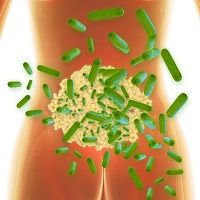Article
Role of Gut Bacteria in Asthma and Allergic Disease Becoming Clearer
Author(s):
Increasing evidence supports the possibility that alterations in gut microbiota may influence susceptibility to asthma and allergic diseases such as eczema and food allergies.

The role of gut microbiota in the development of asthma and allergic diseases is the focus of a brief review published in the August, 2016, issue of Current Opinion in Allergy and Clinical Immunology. According to the review’s authors, the gut is first colonized before and during delivery by maternally derived bacteria, and a critical window may exist during early life when gut dysbiosis exerts the greatest influence on immune development.
Delivery mode, antimicrobial treatment during the perinatal period, infant feeding, and the environment may all influence the composition of the gut microbiome and alter the risk of asthma and allergic disease.
For example, cesarean-delivered infants are at higher risk of asthma and allergic disease than vaginally delivered infants. Escherichia coli, Shigella, Bacteroides, and Bifidobacterium are the main colonizers in vaginally delivered infants. In contrast, skin bacteria such as Staphylococcus and Corynebacterium usually colonize cesarean-born infants. The microbiota of these infants can be partly restored by transferring maternal vaginal microbes to them at birth, but the long-term influence of this procedure remains unclear.
Under optimal conditions, step-wise colonization of the gut leads to a diverse bacterial profile and primes the immune system to tolerate commensals and dietary antigens and react against pathogens appropriately. High biodiversity in the gut microbiome may increase the production of short-chain fatty acids (SCFA), induce immune regulatory pathways, and promote an anti-inflammatory response. In contrast, low biodiversity in the gut microbiome has been associated with decreased production of SCFA, which leads to a shift towards the production of T helper 2 cells and a pro-inflammatory response.
The types and proportions of bacteria that protect against immune-mediated disease remain unclear. However, a Canadian study found that a decreased relative abundance of Faecalibacterium, Lachnospira, Rothia, and Veillonella in early infancy was associated with an increase in the risk of asthma. And in another study, a high level of a biomarker of intestinal inflammation at age 2 months predicted the development of asthma and eczema by age 6 years and was linked to a low abundance of fecal E. coli.
Moreover, a strong association between a high abundance of Faecalibacterium prausnitzii, decreased levels of the SCFA butyrate and propionate, and established eczema was shown in another study that included infants and adults. A low relative abundance of Ruminococcaceae in one-week-old infants has been implicated in the development of atopic eczema. And an elevated ratio of Enterobacteriacea to Bacteriodacea in early infancy has been associated with food sensitization.
These findings have led researchers to study the effectiveness of prevention and treatment strategies based on improving the gut microbiome. For instance, feeding pregnant mice a high-fiber diet was found to suppress the development of experimental allergic airways disease in their pups.
A recent meta-analysis indicated that probiotics, or supplemental beneficial bacteria, help to prevent eczema but not other allergic conditions in humans, and regular intake of lactic acid bacteria was associated with eczema remission in a large survey of Japanese adolescents.
Finally, a meta-analysis of synbiotics for eczema supported their use in treating children, particularly those at least 1 year old. (Synbiotics are probiotics plus prebiotics, fermented ingredients that promote beneficial bacterial growth.)
Related Coverage:
- Pediatric Asthma Flares May be Marked by Boost in Key Clotting Factors
- Weight Gain Worsens Asthma Control, According to Study



